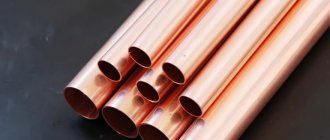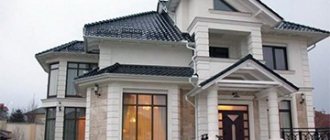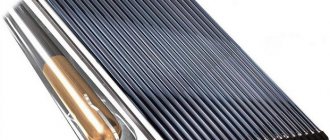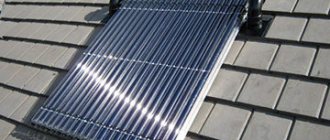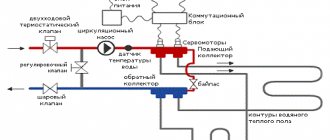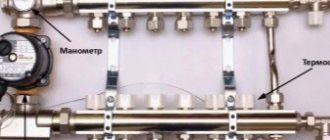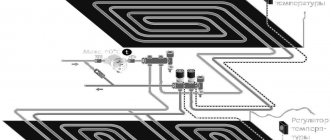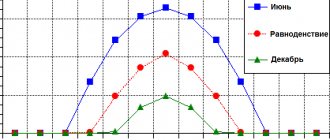What is a collector
A water supply manifold, or simply a “comb”, is essentially a distributor of water flow from a source to consumers. In the case of an apartment, the source is the water supply risers, and the sources are the plumbing fixtures of the apartment.
The scheme of such a water supply system is called parallel or, based on the name of the basic device, collector. Read: Collector water supply scheme. Since the water supply manifold is the basic element of the scheme, you need to choose the manifold for the water supply of your apartment or house as correctly as possible.
Collector installation
It is important to choose the correct cross-section of the pipes. Half-inch diameter pipe fits shower and tank. At the same time, the inlet hole into the distributor must be wider.
Working with modern materials is quite comfortable, and any master can independently assemble the collector. But before starting the work process, you still need to draw up a diagram on paper.
The installation of a water supply system takes place in several stages:
- A faucet or valve on the riser with any water is necessary to turn off the water to repair the water supply system.
- Filter for hard water. Such a filter cleans water from large impurities and makes it drinkable.
- Water meters.
- Pressure reducer - may be needed in a private home. The reducer reduces the pressure if it is too high for your plumbing fixtures. If it is set to the maximum permissible value, it will direct excess water into the drain.
- Collector. It can have from 2 to 6 outputs. You can install several collectors to get the required number of outputs.
The video provides useful tips to help you correctly install the water supply manifold:
Main differences between collectors
To understand the differences between different collectors, let's see how it works. What you see in the next photo is a distribution control manifold from the Italian company FAR.
It consists of a cast body, which distributes the flow of water into branches and shut-off and control valves. Based on the type of valves used in the manifolds or the lack thereof, manifolds can be divided into three types:
Distribution . They are without valves.
Distribution regulating . They not only distribute the flow of water, but can also regulate the outgoing flows by turning the flywheel of the shut-off valve-axlebox.
Distribution shut-off valves . These devices are equipped with shut-off valves rather than control valves. Such valves must operate in two modes: fully open or closed.
The fundamental differences between types of collectors that are important for selection are listed.
Regulating manifolds allow you not only to completely open and close the water, but also to finely regulate the flow of water for each consumer. The adjustment knobs (they are round) allow you to control and adjust the water flow of the water supply without tools.
Distribution shut-off manifolds cannot be used to regulate effluent flows. For them, only open or closed modes are acceptable.
Most often, shut-off manifolds can be distinguished from control manifolds by the characteristic “flag” handles on the valves. The handles (flywheels) of the valve axleboxes of the regulating combs are always in the form of a barrel.
Here it is time to note that collectors are quite clearly divided into collectors for plumbing and for heating. The latter are used in warm water floor systems, sold in pairs (collector groups) and visually have a wider distance between outlets, not 36 mm, but 50 or 100 mm.
For the manifold heating system there are shut-off and regulating, shut-off and balancing, thermoregulating, shut-off and balancing with a flow meter. It is worth noting that some manufacturers allow the use of shut-off and control heating manifolds in water supply systems.
For example, FAR manifolds with protective metal caps. However, FAR manifolds with protective caps do not have adjustment knobs. The cap must be removed and adjustment must be made with a tool. This is not convenient and they are not installed on the water supply of apartments.
How to select and install a suitable collector
Before choosing a collector, determine the number of cold and hot water consumers (this includes taps, toilets, washing machines, dishwashers and other plumbing fixtures). Determine the type of water pipes; the choice of manifold and additional fittings depends on them.
Manifolds with installed valves are easier to install (no need to mount each valve separately)
If the number of consumers does not match the number of taps, purchase several collectors and make one of them. To connect to a supply pipe made of polypropylene or cross-linked polyethylene, purchase manifolds made of these materials. They are cheaper than metal ones, are not inferior in reliability and are easier to install.
Keep in mind that the polypropylene manifold is connected by soldering, and the polyethylene manifold is connected with compression fittings.
If the water supply system does not have hot and cold water filters, a consumption metering system and a check valve, purchase and install them in front of the collector. The location of the devices near the collector, in one inspection hatch, facilitates the repair and maintenance of the water supply system.
If you cannot decide which manifold material is more durable, know that the service life of pipes made of copper, stainless steel and plastics exceeds 50 years, and the service life of ball valves does not exceed 20 years. Therefore, purchase collectors without taps. If the taps fail, you will replace them and the collector will continue to serve.
Polypropylene manifold with taps
Price
The cost of collectors depends on the material, configuration and manufacturer and is listed below:
- Polypropylene, 6 taps, diameter 40x20 mm, KALDE, for soldering - 1600 rubles;
- Polypropylene, 3 taps, diameter 40x20 mm, KALDE, for soldering - 480 rubles;
- Polypropylene, 2 taps, diameter 40x20 mm, KALDE, for soldering - 320 rubles;
- Brass, without taps, 4 outlets, without taps, threaded connections (incoming internal thread, exiting external thread), diameter 1x½ inches, VALTEC - 750 rubles;
- Brass, without taps, 4 outlets, without taps, all threaded connections (internal thread), diameter 1x¾ inches VALTEC – 700 rubles;
- Brass, 3 taps, threaded connections (internal thread in, external thread out), diameter 1x½ inches, VALTEC - 1400 rubles;
- Brass, 4 taps, threaded connections (internal thread in, external thread out), diameter 1x½ inches, ELSEN - 1300 rubles;
- Stainless steel, 4 taps, threaded connections (incoming internal thread, external external thread) 3/4x1/2 inches, FAR - 2200 rubles.
Installation
Having chosen a manifold (assembly of several blocks) for hot and cold water, purchase fittings and additional elements - fluoroplastic sealing material (FUM), rubber gaskets, adapters of the required sizes. It is advisable to purchase manifolds, pipes and fittings from the same manufacturer.
There are cases where pipes, manifolds and fittings from different manufacturers differed in size so much that high-quality assembly was impossible. And I had to buy other fittings. Therefore, before purchasing, check if their sizes match.
Before installing the collector, install water supply lines for each consumer, water filters, meters and a check valve. And only after that install and connect the collector. This sequence of actions will reduce the load on the joints and prevent damage during installation (this is important if you do not have experience in such work).
The use of collectors greatly increases the cost of laying a water supply system and increases the comfort of using water. From the article you learned how to choose collectors, what is needed for their installation and in what sequence to install collector water supply systems.
Author: Sergey Vladimirovich, electrical engineer. More about the author.
Select a manifold for your apartment's water supply by size
Any collector is selected according to the required number of branches. Next, let's look at its dimensions. The smaller the axial distance between the taps, the more compact the collector.
Please note that the taps of some collectors are made at an angle to the taps. This simplifies their maintenance in row installations in cramped conditions.
If there are a large number of branches, do not look for “long” collectors. Take two, for example 3+2 or 4+2 and combine them. This is provided by technology.
Reservoir classification
Switchgears differ in the material of the housing and parts and methods of fastening. This is important to consider when selecting, because... Not all products are suitable for plastic pipes.
The following types of collectors exist:
- Steel (made of stainless steel). Resistant to fire and high temperatures. The products are distinguished by their neat appearance and light weight; the collector is easily mounted on the wall.
- Brass (sometimes nickel-plated). They have a high cost, but are durable. Do not rust or deteriorate from high temperatures.
- Polypropylene. They are lightweight and resistant to corrosion.
According to the method of fixation, devices are classified as follows:
- with eurocone;
- threaded;
- with compression fittings that allow you to firmly connect plastic or metal-plastic pipes;
- with fittings for plastic pipes for soldering;
- combined.
Brass manifolds for water distribution.
The collectors are also available in 2 color options for installation on hot and cold water. Devices are divided by the number of outlets.
Select a water supply manifold based on body material
Collectors are made of brass (sunny shade) or bronze (red, copper shade). Plain brass brands are not coated with anything (eg Tim). Bronze products are not coated with anything (for example, Oventrop). Some brass models are plated with nickel on the outside (for example STOUT). The best manifold models (FAR and UNI-FITT) are completely chrome plated.
Let me explain about chrome plating. According to European laws, nickel must not come into contact with drinking water. Hence the chrome plating and the higher price of the product. This doesn’t work for us, so the Russian Valtec makes manifolds from nickel-plated brass.
Collector water supply system
A separate pipeline is laid from the collector to each of the devices. With this connection method, of course, more pipes will be needed, but the user will benefit from the following:
- All consumers will work with a stable pressure, regardless of the flow rate on other devices.
- It becomes possible to supply water to each device with optimal pressure (a reducer is installed on the collector) and quality (installation of a filter).
- Each pipeline between the collector and a particular device is a solid piece without detachable connections, which allows you to fearlessly hide it in wall or floor structures.
- In case of need for repair or maintenance, any device can be cut off from the water supply without shutting down the entire water supply system.
- In the case of a heating system, its balancing is greatly simplified: the user will be able to achieve a uniform supply of coolant to the radiators while staying in one place.
Collector unit
However, some disadvantages must be taken into account:
- Due to an increase in the length of the pipes, the hydraulic resistance of the system increases, which means that more pressure will be required for normal operation of the devices.
- For the same reason, a collector heating system cannot operate in thermosiphon mode (natural circulation).
If there is no possibility of hidden installation, the system may not look very aesthetically pleasing due to the large number of pipes.
Select a manifold for the water supply of an apartment or house by company
Let me immediately note that the brands of collectors listed below by country may differ from the place of their production; everything needs to be clarified when purchasing.
VALTEC Russia
The Russian company of engineer entrepreneur Pavel Eduardovich Melnikov has been known since 2002. Low price, good quality.
Italian company Far
FAR Rubinetterie SpA was founded in 1974 by Alberto Alessina and Guerino Alessina and Nicola Rovaletti. QAVR quality certificate, Green Valve brand.
Italian Tiemme
On the market since 1990. It is proud to carry out its entire production cycle in Italy to ensure the quality, safety and reliability of its products.
Italian Luxor
Luxor Minuterie Idrauliche was founded in 1960 in Carpenedolo. All products comply with ISO 9001:2015 certification, Certified in Russia.
UNI-FITT Italy
The Italian brand has 19 enterprises in Europe and 9 factories in Russia. On the Russian market since 2010. Externally very similar to FAR.
General fittings
GF collectors come from Italy. There are manifolds with shut-off ball valves and control valves. Large selection of types and sizes, material nickel-plated brass.
Calleffi
Another “Italian” from 12 companies and 5 representative offices. All 3 factories are located in Italy. There are no crafts.
Polish Solomon
Cheap Polish-Chinese brass miracle. You need to look in Russia.
STOUT
European brand with factories in Russia, Italy, Spain, Germany. Products in the mid-price range, with nice, unfolded white handles. More used for heated floors.
Tim
TIM company was founded in 1994. produces a wide range of manifolds for heating and plumbing. The TIM Group unites 6 factories in China and distributors throughout Europe, Russia and the USA.
German Rehau
A narrow range of brass distribution combs for sliding sleeves and nickel-plated distribution manifolds with continuously adjustable 4 outlets. Large selection of collector groups for heated floors.
Installation
https://www.youtube.com/watch?v=Zx7yBVxpGJI
The main feature of the procedure is that among all plumbing fixtures, including taps, meters and consumers, water supply collectors are installed last.
Before starting the system, you need to make sure that it is sealed. To do this, turn off all taps, and water is supplied progressively through each branch in order to promptly detect the presence of leaks. Qualified plumbers have learned from personal experience that there are a number of features that can only be learned from their own experience, and not from literature.
Selecting a manifold by diameter, thread and connection method
The most difficult moment of choice, which I will continue in the following articles. Some necessary information:
- The outlets of all control and shut-off manifolds have external threads (M).
- The diameter of inlets and outlets is indicated in inches (1/2.3/4.1″);
- Pass-through manifolds are threaded on both sides of the main flow. By type of thread they are designated: VR-BP (internal thread - internal thread) and NR-BP (external - internal);
- Bends with external metric thread M24x19 are designated as MR;
- Manifolds with flat seal outlets (FLAT-FACED) are additionally marked TP;
- Metric thread M24x19 is more reliable than simple pipe thread. It can be tightened by hand, for example, a flexible liner;
- The flat seal bends are connected to the gasket. They are used to connect manifolds and pipes (equipment) from different manufacturers;
- The Euroconus connection does not require sealing gaskets and works on an O-ring (collet connection). It withstands temperature changes well. Used to connect metal-plastic, PEX and copper pipes. To convert a Eurocone to a flat seal, there are special adapters.
solar collector
In the summer, each square meter of the ground surface brightly illuminated by the midday sun receives about a kilowatt of heat. Taking into account the decrease in insolation at the beginning and end of the day, a square of soil absorbs an average of 4-5 kWh of thermal energy per day.
The best examples of solar collectors allow you to utilize up to 95% of this energy, using it for hot water supply or heating.
Varieties
On sale you can find two types of devices of this class:
| Image | Description |
| A flat-plate collector is a blackened thermally conductive substrate covered with a transparent material (glass or polycarbonate), on which water tubes (copper, made of cross-linked polyethylene and other materials) are attached. |
| Tubular or vacuum collector - several thermos tubes with a heat-absorbing coating on the surface of the inner flask. The vacuum between the walls of the tubes avoids losses due to convection. |
Efficiency mark
Let's try to evaluate the efficiency and payback period of solar collectors. We will assign the role of the object for research to an inexpensive domestic product with the spectacular name “Hurricane-700”.
Collectors "Hurricane"
First, some dry numbers:
- The dimensions of the water supply collector are 1x2 meters;
- The maximum effective thermal power of the device when positioned perpendicular to the sun's rays is 1170 watts;
- In summer, the device is capable of generating about 7 kWh per day;
- The retail cost of the water heater is 14,900 rubles.
However: when installing on a flat roof or on the ground surface, you will additionally need to purchase a holding frame costing 3,120 rubles.
Frame for installing the collector on a flat platform
What the buyer will get for this money:
- Installation of a water supply collector into the DHW circuit will allow you to heat 1000 liters of water at 6.5 degrees or 150 liters at 37 degrees absolutely free of charge every day;
- At current electricity tariffs (on average about 5 rubles per 1 kWh), solar heat will save 7 * 5 = 35 rubles daily;
- The cost of the collector in an ideal scenario (read - when operating only in the summer and in the absence of cloudy days) will pay off in 14900/35 = 426 (rounded) days. In practice, the real payback period will be 3-4 years.
Connection diagram
The main problem associated with solar collectors is the unevenness of heat production throughout the day. It is solved by installing an indirect heating boiler in the DHW circuit, which accumulates hot water and maintains its temperature thanks to the thermal insulation of the walls. A low-power circulation pump is responsible for circulating water between the collector and the boiler.
Connection diagram for collectors for hot water supply needs
manifold mounting
I looked through the entire section and I can’t find how to secure the collector so as not to accidentally collapse
Look at photos of examples of completed work, manufacturers' catalogs. Either specialized fasteners for “steep manifolds” or ordinary plumbing clamps on plumbing studs are used.
x-men wrote: Either specialized fasteners for “steep manifolds” or ordinary plumbing clamps on plumbing studs are used.
If the collector is in a metal collector cabinet, then special fasteners, otherwise - plumbing clamps on plumbing studs.
Please give me some advice: are the collectors attached correctly and can the play of the fasteners in the brick wall affect the operation of the system? (Behind the brick there is one row of emptiness). Thank you.
Dmitry wrote: are the collectors attached correctly?
Right. But everything else is not. Use polypropylene for manifold wiring. bue.
psnsergey wrote: Use polypropylene for collector wiring. bue.
Exclusively metal-plastic? This is polypropylene with fiberglass.
As far as I understand, the choice of material is related to the number of hidden connections from the collector to the consumers? Or something else?
Dmitry - yes. Number of connections and ease of installation.
Dmitry wrote: As far as I understand, the choice of material is related to the number of hidden connections from the collector to the consumers? Or something else?
Here's what's about it
Rules for installing water supply systems
For the water supply you will also need two collectors: one for hot water, the second for cold water.
In this case, there is no need to install control valves - a shut-off valve is sufficient. Typically, taps on manifolds for cold water are equipped with blue handles, and for hot water - red.
The water supply manifold should be installed in a dry place: in a closet, for example, or in a corridor.
The ideal option is installation in a cabinet (the collector is equipped with special fasteners), but if you are not going to spend money on buying it yet, you can simply place the part in some niche.
As already mentioned, the absence of connections on the pipes between the devices and the collector allows them to be laid in a hidden manner. It should be taken into account that gating of load-bearing walls is not allowed. When laying hidden, all pipes, even with cold water, must be covered with a sleeve made of foamed polyethylene. This material will provide the gap between the pipe walls and the solution necessary to compensate for free thermal expansion.
Bathroom renovations involve not only replacing plumbing fixtures, but also installing new pipes. Laying out pipes in the bathroom with your own hands - dismantling used pipes and methods for installing new equipment, read about this in the next topic.
Is it worth it to drain the floor in a shower and what are the advantages and disadvantages of a simplified drain system? Read this link.
Recommendations for installing the device
At the design stage, the location where the collector group will be installed should be determined. Most often, it is mounted in a special cabinet, which must be of sufficient size to accommodate all the elements. The equipment is installed at a certain height from the floor near the main pipes.
In this case, you need to place the cabinet so that there is free space for bending the pipes suitable for the manifold. It is desirable that it be placed at the same distance from all heating circuits. If desired, the cabinet can be mounted in a specially made niche or simply attached to the wall.
The figure shows a diagram of the collector assembly. This is how the manufacturer completes the equipment
Assembling a complete manifold for underfloor heating is quite simple. However, before starting work, you should carefully read the instructions, which the manufacturer necessarily includes in the packaging of the equipment. All operations should be performed in strict accordance with its recommendations.
In general terms, assembly is carried out in the following sequence:
- We remove the tubes intended for return and supply coolant from the packaging. They should already be equipped with flow sensors and valves. If the collector is divided into several sections, twist them together.
- We fix the assembled pipes on standard brackets, which will allow you to continue working with greater convenience. The distributor is now a single unit.
- We install shut-off valves, connecting elements, plugs and control devices in place.
- We fix the collector to the wall. You can find recommendations that suggest first installing a valve and a circulation pump. However, in this case it will be very inconvenient to subsequently attach the assembled unit.
- We install a circulation pump and a valve with a servo drive and a thermal head in accordance with the selected scheme.
- We connect the pipes coming from the heating boiler to the unit, and we connect the pipes from the heated floor circuits to the outlets.
The manifold for heated floors is best mounted in a cabinet specially designed for this purpose, which can be “recessed” into the wall or simply mounted on it.
All commissioning work should be carried out before the concrete screed is poured. This is necessary to ensure the tightness of all joints made. We configure the collector.
We check the operation of all control devices that allow you to set the desired floor heating mode, as well as adjust the coolant flows in each circuit.
Collector advantages:
1. Convenient All communications are located in this place. For example, there is no need to crawl under the sink to turn off a faucet in which the faucet axle is faulty. This is especially true if there is only one pregnant woman or children left at home. It will be enough to close the required tap on the collector.
2. Reliably One solid pipe goes from the collector to the consumer without connections. In the case of a high-quality pipe, leaks in sealed walls are excluded. (although if during tee wiring the connections were, for example, made of polypropylene (soldering), then a leak is also impossible)
3. No pressure drops In the case of manifold wiring and the presence of operating pressure, there are almost completely no pressure drops when using, for example, two sinks at the same time. Moreover, you can limit the water supply to each consumer. True, if a manifold with valve taps is installed. You can limit the water supply, for example to the toilet, if the pressure in the system is too low. And the fact that the toilet will fill 2 or 3 times slower than when fully open will not affect anything.
